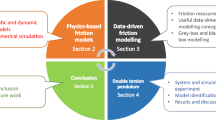Abstract
This paper aims to present a method for improving the modeling precision of static friction. To some extent, as the traditional static friction models available can’t be unified to characterize all the friction situations, a back propagation neural network (BPNN) was proposed to weaken the requirements of traditional static friction models. In details, relative speed of interacting surfaces and joint load are typically considered as the inputs of BPNN, whose output is the predicted static friction. Furthermore, to speed up the convergence and improve the global generalization capability of BPNN, we use genetic algorithm (GA) to optimize the initial values of weights and thresholds. All the training samples follow with reciprocating constant-speed experiments of friction under the changes of joint speed and load. Three comparative experiments indicate that using GA to optimize the initial values of weights and thresholds benefit to improve the convergence rate of network and prediction accuracy, and comparing with the traditional model of static friction, the BPNN model has a higher prediction precision and excellent generalization capability.
Similar content being viewed by others
References
Guillo, M., Dubourg, L.: Impact & improvement of tool deviation in friction stir welding: weld quality & real-time compensation on an industrial robot. Robot Cim-Int Manuf. 39, 22–31 (2016)
Simoni, L., Beschi, M., Legnani, G., Visioli, A.: Friction Modeling with Temperature Effects for Industrial Robot Manipulators. In: 2015 IEEE/RSJ International Conference on Intelligent Robots and Systems (IROS), pp 3524–3529. IEEE (2015)
Zi, B., Qian, S.: Design Analysis and Control of Cable-Suspended Parallel Robots and its Applications. Springer, Berlin (2017)
Zi, B., Ding, H., Cao, J., et al.: Integrated mechanism design and control for completely restrained hybrid-driven based cable parallel manipulators. J Intell Robot Syst. 74(3-4), 643–661 (2014)
Swevers, J., Al-Bender, F., Ganseman, C.G., Projogo, T.: An integrated friction model structure with improved presliding behavior for accurate friction compensation. IEEE T Autom. Contr. 45(4), 675–686 (2000)
Bittencourt, A.C., Axelsson, P.: Modeling and experiment design for identification of wear in a robot joint under load and temperature uncertainties based on friction data. IEEE-ASME T Mech. 19(5), 1694–1706 (2014)
Olsson, H., ÅStröm, K.J., Canudas De Wit, C., et al.: Friction models and friction compensation. Eur. J Control. 4(3), 176–195 (1998)
Morin, A.J.: New friction experiments carried out at Metz in 1831–1833. Proc. French Royal Acad. Sci. 4(1), 128 (1833)
Stribeck, R.: The key qualities of sliding and roller bearings. Zeitschrift des Vereines Seutscher Ingenieure. 46 (38), 39 (1902)
Dohring, M.E., Lee, E., Newman, W.S.: A load-dependent transmission friction model: theory and experiments. In: Proceedings of the IEEE International Conference on Robotics and Automation, pp 430–436 (1993)
Hamon, P., Gautier, M., Garrec, P.: Dynamic Identification of Robots with a Dry Friction Model Depending on Load and Velocity. In: Proceedings of the IEEE/RSJ International Conference on Intelligent Robots and Systems (IROS), pp 6187–6193 (2010)
Wu, W.: Joint Friction Analysis and Low-Speed High-Precision Motion Control of Multi-DOF Serial Robots ZheJiang University (2013)
Visioli, A., Legnani, G.: On the trajectory tracking control of industrial SCARA robot manipulators. IEEE T Ind. Electron. 49(1), 224–232 (2002)
Smola, A.J., Schölkopf, B.: A tutorial on support vector regression. Stat. Comput. 14(3), 199–222 (2004)
Burges, C.J.: A tutorial on support vector machines for pattern recognition. Data Min Knowl. Disc. 2(2), 121–167 (1998)
Li, J., Cheng, J., Shi, J., Huang, F.: Brief Introduction of Back Propagation (BP) Neural Network Algorithm and Its Improvement, vol. 169, pp 553–558. Springer, Berlin (2012)
Jin, W., Li, Z.J., Wei, L.S., Zhen, H.: The improvements of BP neural network learning algorithm. In: Proceedings of the 5th International Conference on Signal Processing, 2000. WCCC-ICSP 2000, vol. 3, pp 1647–1649 (2000)
Ding, S., Su, C., Yu, J.: An optimizing BP neural network algorithm based on genetic algorithm. Artif. Intell. Rev. 36(2), 153–162 (2011)
Yi, J., Wang, Q., Zhao, D., Wen, J.T.: BP Neural network prediction-based variable-period sampling approach for networked control systems. Appl. Math. Comput. 185(2), 976–988 (2007)
Tang, H., Tan, K.C., Zhang, Y.: Neural Networks: Computational Models and Applications. Wiley, Chichester (2003)
Demuth, H.B., Beale, M.H., De Jess, O., Hagan, M.T.: Neural Network Design, Martin Hagan (2014)
Acknowledgments
Research was supported by National Natural Science Foundation of China (Project number: 51375194 and 51575411), State Key Lab of Digital Manufacturing Equipment & Technology, School of Mechanical Science and Engineering, Huazhong University of Science & Technology, and Fundamental Research Funds for the Central University (WUT:2017111046).
Author information
Authors and Affiliations
Corresponding author
Rights and permissions
About this article
Cite this article
Tu, X., Zhou, Y., Zhao, P. et al. Modeling the Static Friction in a Robot Joint by Genetically Optimized BP Neural Network. J Intell Robot Syst 94, 29–41 (2019). https://doi.org/10.1007/s10846-018-0796-6
Received:
Accepted:
Published:
Issue Date:
DOI: https://doi.org/10.1007/s10846-018-0796-6



